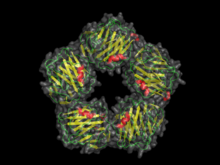Pentraxins
| Pentaxin family | |||||||||
|---|---|---|---|---|---|---|---|---|---|

|
|||||||||
| Identifiers | |||||||||
| Symbol | Pentaxin | ||||||||
| Pfam | PF00354 | ||||||||
| InterPro | IPR001759 | ||||||||
| PROSITE | PDOC00261 | ||||||||
| SCOP | 1sac | ||||||||
| SUPERFAMILY | 1sac | ||||||||
|
|||||||||
| Available protein structures: | |
|---|---|
| Pfam | structures |
| PDB | RCSB PDB; PDBe; PDBj |
| PDBsum | structure summary |
Pentraxins (PTX), also known as pentaxins, are an evolutionary conserved family of proteins characterised by containing a pentraxin protein domain. Proteins of the pentraxin family are involved in acute immunological responses. They are a class of pattern recognition receptors (PRRs). They are a superfamily of multifunctional conserved proteins, some of which are components of the humoral arm of innate immunity and behave as functional ancestors of antibodies (Abs). They are known as classical acute phase proteins (APP), known for over a century.
Pentraxins are characterised by calcium dependent ligand binding and a distinctive flattened β-jellyroll structure similar to that of the legume lectins. The name "pentraxin" is derived from the Greek word for five (penta) and berries (ragos) relating to the radial symmetry of five monomers forming a ring approximately 95Å across and 35Å deep observed in the first members of this family to be identified. The "short" pentraxins include Serum Amyloid P component (SAP) and C reactive protein (CRP). The "long" pentraxins include PTX3 (a cytokine modulated molecule) and several neuronal pentraxins.
Three of the principal members of the pentraxin family are serum proteins: namely, C-reactive protein (CRP), serum amyloid P component protein (SAP), and female protein (FP).PTX3 (or TSG-14) protein is a cytokine-induced protein that is homologous to CRPs and SAPs, but its function has not yet been determined.
C-reactive protein is expressed during acute phase response to tissue injury or inflammation in mammals. The protein resembles antibody and performs several functions associated with host defence: it promotes agglutination, bacterial capsular swelling and phagocytosis, and activates the classical complement pathway through its calcium-dependent binding to phosphocholine. CRPs have also been sequenced in an invertebrate, Limulus polyphemus (Atlantic horseshoe crab), where they are a normal constituent of the hemolymph.
...
Wikipedia
